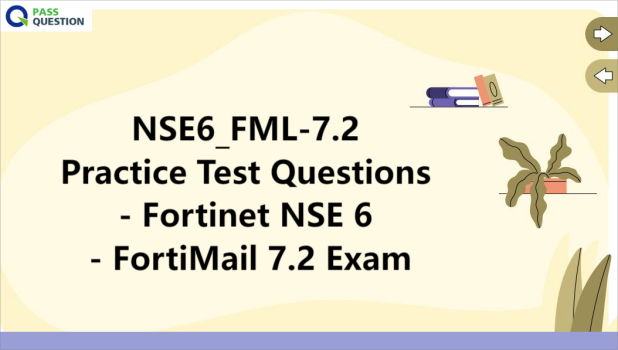NSE6_FML-7.2 Practice Test Questions - Fortinet NSE 6 - FortiMail 7.2 Exam
The best way to prepare for the NSE6_FML-7.2 Fortinet NSE 6 - FortiMail 7.2 Exam is by practicing with the latest NSE6_FML-7.2 Practice Test Questions from PassQuestion. These NSE6_FML-7.2 Practice Test Questions are designed to simulate the actual exam and provide you with a better understanding of the exam format and type of questions that will be asked. PassQuestion offers a wide range of NSE6_FML-7.2 Practice Test Questions that are updated regularly to reflect the latest exam objectives and changes. With PassQuestion, you can be sure that you are getting the most up-to-date and accurate practice questions to help you pass the Fortinet NSE 6 - FortiMail 7.2 Exam successfully.

NSE6_FML-7.2 Exam Overview - Fortinet NSE 6 - FortiMail 7.2 Exam
The Fortinet NSE 6 - FortiMail 7.2 exam is part of the NSE 6 Network Security Specialist program, and recognizes the successful candidate’s knowledge of and expertise with FortiMail devices. The exam tests applied knowledge of FortiMail configuration, operation, and day-to-day administration, and includes
operational scenarios, configuration extracts, and troubleshooting captures. The Fortinet NSE 6 - FortiMail 7.2 exam is intended for security professionals involved in the configuration, administration, management, monitoring, and troubleshooting of FortiMail devices in small to enterprise deployments.
Fortinet NSE6_FML-7.2 Exam Information
Exam name: Fortinet NSE 6 - FortiMail 7.2
Exam series: NSE6_FML-7.2
Time allowed: 60 minutes
Exam questions: 31 multiple-choice questions
Scoring Pass or fail, a score report is available from your Pearson VUE account
Language: English and Japanese
Product version: FortiMail 7.2
Fortinet NSE 6 - FortiMail 7.2 NSE6_FML-7.2 Exam Objectives
Successful candidates have applied knowledge and skills in the following areas and tasks:
Initial deployment and basic configuration
- Describe the fundamentals of SMTP and email flow
- Complete basic setup of FortiMail operation mode, system settings and protected domains
- Deploy FortiMail high-availability clusters
- Monitor and troubleshoot deployment and configuration issues
Email flow and authentication
- Enable and enforce authentication on FortiMail
- Configure secure MTA features
- Configure and track access control rules, IP, and recipient policies
- Monitor and troubleshoot email flow and authentication issues
Email security
- Configure session-based email filtering
- Explain and apply spam filtering techniques
- Configure for anti-malware and advanced persistent threat mitigation
- Configure content-based email filtering and archiving
- Monitor and troubleshoot email security issues
Encryption
- Explain traditional SMTP encryption methods
- Configure identity-based encryption (IBE)
- Manage IBE users
Server mode and transparent mode
- Explain server mode specific features
- Deploy FortiMail in transparent mode
View Online Fortinet NSE 6 - FortiMail 7.2 NSE6_FML-7.2 Free Questions
1. Which two FortiMail antispam techniques can you use to combat zero-day spam? (Choose two.)
A.IP reputation
B.Spam outbreak protection
C.DNSBL
D.Behavior analysis
Answer: A, B
2. Which statement about how impersonation analysis identifies spoofed email addresses is correct?
A.It uses behavior analysis to detect spoofed addresses.
B.It uses DMARC validation to detect spoofed addresses.
C.It maps the display name to the correct recipient email address
D.It uses SPF validation to detect spoofed addresses.
Answer: B
3. While reviewing logs, an administrator discovers that an incoming email was processed using policy IDs 0:4:9:INTERNAL.
Which two statements describe what this policy ID means? (Choose two.)
A.Access control policy number 9 was used.
B.The FortiMail configuration is missing an access delivery rule.
C.The email was processed using IP-based policy ID 4.
D.FortiMail is applying the default behavior for relaying inbound email.
Answer: A, C
4. An organization has different groups of users with different needs in email functionality, such as address book access, mobile device access, email retention periods, and disk quotas.
Which FortiMail feature specific to server mode can be used to accomplish this?
A.Resource profiles
B.Domain-level service settings
C.Access profiles
D.Address book management options
Answer: A
5. Which two features are available when you enable HA centralized monitoring on FortiMail? (Choose two.)
A.Policy configuration changes of all cluster members from the primary device.
B.Mail statistics of all cluster members on the primary device.
C.Cross-device log searches across all cluster members from the primary device.
D.Firmware update of all cluster members from the primary device
Answer: B, C
6. While reviewing logs, an administrator discovers that an incoming email was processed using policy IDs 0:4:9:INTERNAL.
Which two statements describe what this policy ID means? (Choose two.)
A.Access control policy number 9 was used.
B.The FortiMail configuration is missing an access delivery rule.
C.The email was processed using IP-based policy ID 4.
D.FortiMail is applying the default behavior for relaying inbound email.
Answer: A, C
- TOP 50 Exam Questions
-
Exam
All copyrights reserved 2025 PassQuestion NETWORK CO.,LIMITED. All Rights Reserved.

